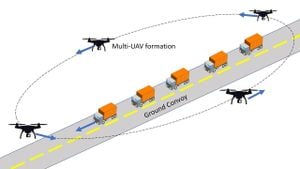Vietnam’s agricultural sector is facing significant changes as it navigates the looming threats of trade wars, especially with the United States. Despite these challenges, Vietnamese exporters show remarkable resilience, maintaining their competitiveness on the global market. Reports indicate Vietnam's trade surplus with the US has reached $123.5 billion, primarily buoyed by agricultural exports such as pepper, cashews, and coffee.
Intimex Group, one of Vietnam's largest agricultural exporters, demonstrates the potential for adaptation amid varying import tariffs enforced by the US. According to Do Ha Nam, Chairman of Intimex, key products of the company are exempt from these tariffs since the US does not produce them internally. Specifically, Vietnam is recognized as the leading supplier of coffee beans to the US market, which accounted for nearly $400 million, representing a remarkable increase of 33% year-on-year. Nam expressed concern, though, about the long-term impacts of US trade measures on domestic demand, forecasting potential declines as higher pricing could deter consumers.
Nam stated, "While we were able to capitalize on opportunities, there is still uncertainty surrounding potential new tariffs. We must remain vigilant about how they will impact our business operations and the wider agricultural export sector." He also added, "If the costs rise significantly due to tariffs, it could curtail demand for Vietnamese products, including coffee and other agricultural goods." This sentiment resonates with industry stakeholders who ponder the future amid disruptive trade measures.
Hoang Thi Lien, Chairwoman of the Vietnam Pepper and Spice Association, echoed similar sentiments. She indicated if the US imposes new tariff measures, they would likely lead to reduced competitiveness for Vietnamese pepper and spice products. Currently, the United States is responsible for 29% of Vietnam’s pepper exports, highlighting its significance as a buyer.
Interestingly, some businesses, including Phuc Sinh Corporation, have proactively shifted their strategies. Phuc Sinh, which exports over 60,000 tonnes of coffee and 30,000 tonnes of pepper annually, is diversifying their markets to diminish US dependency. Phan Minh Thung, Chairman of Phuc Sinh, shared, "We’ve focused on producing higher-value products through deep processing instead of selling raw materials alone. It’s pivotal to broaden our reach beyond traditional markets to mitigate risks from volatile trade conditions."
Meanwhile, as Vietnamese companies tap alternative markets, exports to the Middle East have reportedly doubled, and instant coffee exports to China surged over tenfold compared to the previous year, evidencing adaptability to changing global conditions. Nam noted, “This is not merely about survival; it's about seizing opportunities where others might falter.”
On the other hand, recent developments from the US energy sector signal consequential changes for global markets. The new administration has taken steps to bolster domestic energy production, implementing policies to increase liquefied natural gas (LNG) exports. Significant investments are anticipated, prompting businesses to develop infrastructure capable of supporting increased extraction and exportation, directly benefitting US natural gas producers.
Critics of this decision caution about the environmental ramifications, asserting more LNG exports could exacerbate global greenhouse gas emissions. Assessments from recent studies show how rising US LNG production, beyond transforming the nation from net importer to leading exporter, could trigger volatility within domestic energy pricing, projecting increases akin to imposing substantial carbon taxes. The interplay between rising LNG exports and the global energy market remains complex.
Research findings highlight regulatory changes enabling US LNG exports may lead to higher energy prices domestically, which, according to experts, could disturb the balance between energy availability and environmental sustainability. One such study by analysts Jim Stock and Matthew Zaragoza-Watkins outlines potential price hikes under forthcoming energy policies, stating, "Greater reliance on LNG exports could raise domestic natural gas prices significantly, potentially impacting both consumers and environmental outcomes as the global energy mix shifts favoring gas over traditional coal sources.”
The EU, too, is introducing regulations influencing agricultural import dynamics through the Carbon Border Adjustment Mechanism (CBAM). This new policy mandates importers of fertilizers to account for embedded emissions, effectively creating financial incentives for reduced carbon emissions. With the EU relying heavily on fertilizer imports from countries like Algeria and Egypt, this significant shift requires companies to invest more heavily, driving innovation within their production processes. The salient goal is to transition to cleaner industrial manufacturing globally, fostering potential collaborations between importers and exporters.
Starting January 2026, importers will face increased costs associated with purchasing CBAM certificates, reflective of their imported fertilizer's carbon content. This could alter the cost structure of agriculture equipment within the EU, potentially leading to heightened prices for end consumers.
For agricultural businesses, compliance to these new standards is not just about adhering to regulations—it also presents the opportunity to initiate sustainable practices. By developing cleaner production methodologies such as using byproducts from food waste, companies can reduce their vulnerability to rising costs stemming from compliance with CBAM, all the whilst promoting sustainability across the supply chains.
While lawmakers and industry leaders from different regions grapple with the ramifications of their respective export policies, Brazil, the world's leading soybean exporter, displays slow growth relative to soybean shipments compared to last year's period. Reports indicate the current rate of exports for February is trailing behind, with only 246,500 metric tons shipped per day, amounting to 29% less than their daily average from the previous year. This downturn invokes concern among stakeholders about competitive pressures and market adjustments required as they react to fluctuated global demands.
The situation starkly displays the interconnected nature of global markets where trade, energy policies, and environmental regulations converge, creating both risks and opportunities for stakeholders. Although the road appears challenging, the agility of exporters across these sectors may determine their resilience against broader market susceptibilities.



